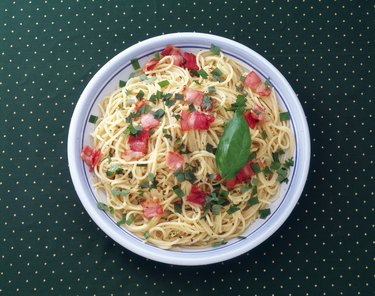
Thanks to its affordability and versatility in the kitchen, pasta makes up a staple in the average American diet. In fact, the average American consumes 20 pounds of it annually, according to North Dakota State University. Pasta provides you with energy, as well as essential nutrients in the form of fiber, vitamins and minerals. Pair your pasta with healthful ingredients to prepare nutrient-packed meals.
Carbohydrates and Fiber
Video of the Day
Pasta provides beneficial carbohydrates. A cup of white spaghetti contains 43 grams of total carbohydrates, while an equivalent serving of whole-wheat spaghetti offers 37 grams of total carbs. Carbs serve as a primary source of fuel for your body. Whole-wheat pasta also provides a considerable amount of dietary fiber, a particularly beneficial type of carbohydrate. Fiber helps fight chronic diseases -- including obesity and type 2 diabetes -- and promotes digestive health. A 1-cup serving of whole-wheat pasta contains 6.3 grams of dietary fiber, providing 17 percent of the recommended daily intake for men and 24 percent for women, set by the Institute of Medicine. White pasta is lower in fiber, at 2.5 grams per serving.
Video of the Day
Selenium and Manganese
Both white and whole-wheat pastas serve as excellent sources of selenium, a mineral that activates antioxidant enzymes tasked with protecting your cells from molecular damage. A 1-cup serving of either type of pasta provides roughly two-thirds of your recommended daily intake, determined by the Institute of Medicine. Pasta also contains manganese, a mineral that helps you metabolize carbohydrates and regulate your blood sugar. A serving of whole-wheat pasta boasts 1.9 milligrams of manganese -- more than 100 percent of the daily intake for women and 83 percent for men -- while an equivalent serving of white pasta offers 0.5 milligram.
Folate and Carotenoids
Eat white pasta as a source of folate -- or vitamin B-9 -- or opt for whole-wheat pasta as a source of the carotenoids lutein and zeaxanthin. Folate plays a role in red blood cell development and supports rapid cell growth, while lutein and zeaxanthin support healthy vision. A diet rich in carotenoids, including lutein and zeaxanthin, also reduces the risk of lung cancer, explains the Linus Pauling Institute. A serving of white pasta provides 167 micrograms of vitamin B-9, or 42 percent of the daily recommended folate intake established by the Institute of Medicine. A serving of whole-wheat pasta contains 113 micrograms of lutein and zeaxanthin.
Make It Healthy
Use pasta as a base for healthful dishes rich in veggies, lean proteins and healthy fats. Light coat whole-wheat spaghetti with olive oil, then mix in wilted greens and chopped hazelnuts for a decadent but healthful and easy-to-prepare meal. Top pasta with roasted veggies -- including fennel, red peppers, onions and garlic -- and then it with tomato sauce and basil. Alternatively, incorporate pasta into cold salads. Whole-wheat rotini pairs well with chopped kalamata olives, roasted red peppers and a lemon juice vinaigrette, while bowties, steamed shrimp, red bell pepper and red pepper flake-infused olive oil mix for a fiery salad option.
- North Dakota State University: Pasta Month
- Linus Pauling Institute: Fiber
- USDA National Nutrient Database: Spaghetti, Cooked, Enriched, With Added Salt
- USDA National Nutrient Database: Spagetti, Whole-Wheat, Cooked
- University of Maryland Medical Center: Selenium
- University of Maryland Medical Center: Manganese
- University of Maryland Medical Center: Vitamin B-9 (Folic Acid)
- Linus Pauling Institute: Carotenoids
- McKinley Health Center: Macronutrients: the Importance of Carbohydrate, Protein, and Fat